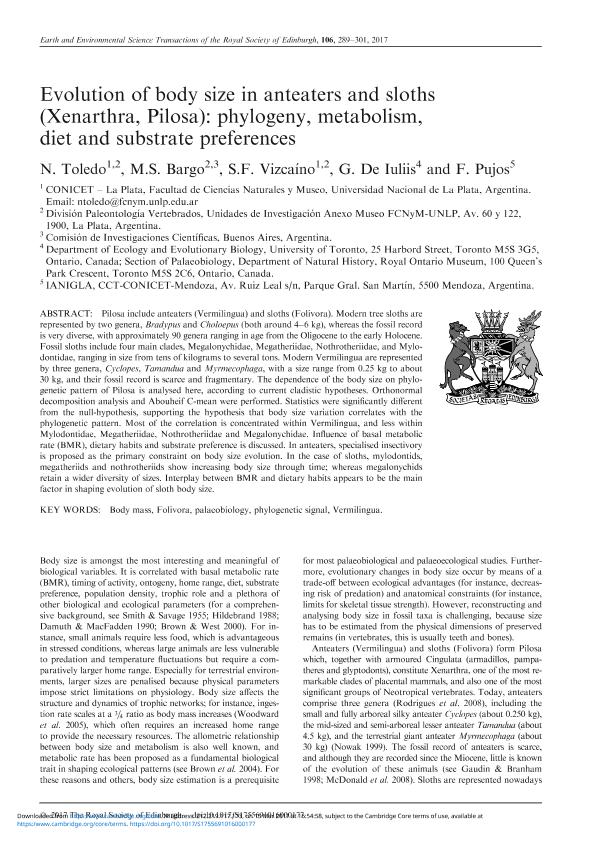Artículo
Evolution of body size in anteaters and sloths (Xenarthra, Pilosa): Phylogeny, metabolism, diet and substrate preferences
Toledo, Néstor ; Bargo, María Susana; Vizcaíno, Sergio Fabián
; Bargo, María Susana; Vizcaíno, Sergio Fabián ; De Iuliis, G.; Pujos, François Roger Francis
; De Iuliis, G.; Pujos, François Roger Francis
 ; Bargo, María Susana; Vizcaíno, Sergio Fabián
; Bargo, María Susana; Vizcaíno, Sergio Fabián ; De Iuliis, G.; Pujos, François Roger Francis
; De Iuliis, G.; Pujos, François Roger Francis
Fecha de publicación:
02/2017
Editorial:
Royal Society of Edinburgh
Revista:
Earth and Environmental Science Transactions of the Royal Society of Edinburgh
ISSN:
1755-6910
Idioma:
Inglés
Tipo de recurso:
Artículo publicado
Clasificación temática:
Resumen
Pilosa include anteaters (Vermilingua) and sloths (Folivora). Modern tree sloths are represented by two genera, Bradypus and Choloepus (both around 4-6 kg), whereas the fossil record is very diverse, with approximately 90 genera ranging in age from the Oligocene to the early Holocene. Fossil sloths include four main clades, Megalonychidae, Megatheriidae, Nothrotheriidae, and Mylodontidae, ranging in size from tens of kilograms to several tons. Modern Vermilingua are represented by three genera, Cyclopes, Tamandua and Myrmecophaga, with a size range from 0.25 kg to about 30 kg, and their fossil record is scarce and fragmentary. The dependence of the body size on phylogenetic pattern of Pilosa is analysed here, according to current cladistic hypotheses. Orthonormal decomposition analysis and Abouheif C-mean were performed. Statistics were significantly different from the null-hypothesis, supporting the hypothesis that body size variation correlates with the phylogenetic pattern. Most of the correlation is concentrated within Vermilingua, and less within Mylodontidae, Megatheriidae, Nothrotheriidae and Megalonychidae. Influence of basal metabolic rate (BMR), dietary habits and substrate preference is discussed. In anteaters, specialised insectivory is proposed as the primary constraint on body size evolution. In the case of sloths, mylodontids, megatheriids and nothrotheriids show increasing body size through time; whereas megalonychids retain a wider diversity of sizes. Interplay between BMR and dietary habits appears to be the main factor in shaping evolution of sloth body size.
Palabras clave:
BODY MASS
,
FOLIVORA
,
PALAEOBIOLOGY
,
PHYLOGENETIC SIGNAL
,
VERMILINGUA
Archivos asociados
Licencia
Identificadores
Colecciones
Articulos(CCT - LA PLATA)
Articulos de CTRO.CIENTIFICO TECNOL.CONICET - LA PLATA
Articulos de CTRO.CIENTIFICO TECNOL.CONICET - LA PLATA
Articulos(IANIGLA)
Articulos de INST. ARG. DE NIVOLOGIA, GLACIOLOGIA Y CS. AMBIENT
Articulos de INST. ARG. DE NIVOLOGIA, GLACIOLOGIA Y CS. AMBIENT
Citación
Toledo, Néstor; Bargo, María Susana; Vizcaíno, Sergio Fabián; De Iuliis, G.; Pujos, François Roger Francis; Evolution of body size in anteaters and sloths (Xenarthra, Pilosa): Phylogeny, metabolism, diet and substrate preferences; Royal Society of Edinburgh; Earth and Environmental Science Transactions of the Royal Society of Edinburgh; 106; 4; 2-2017; 289-301
Compartir
Altmétricas



